How to remove Stealit malware from the operating system
TrojanAlso Known As: Stealit Remote Access Trojan (RAT)
Get free scan and check if your device is infected.
Remove it nowTo use full-featured product, you have to purchase a license for Combo Cleaner. Seven days free trial available. Combo Cleaner is owned and operated by RCS LT, the parent company of PCRisk.com.
What kind of malware is Stealit?
Stealit is a multifunctional malicious program that operates as a RAT (Remote Access Trojan), spyware, stealer, and ransomware. There is a Windows and an Android version of this malware. Stealit's developers are offering it for sale online.
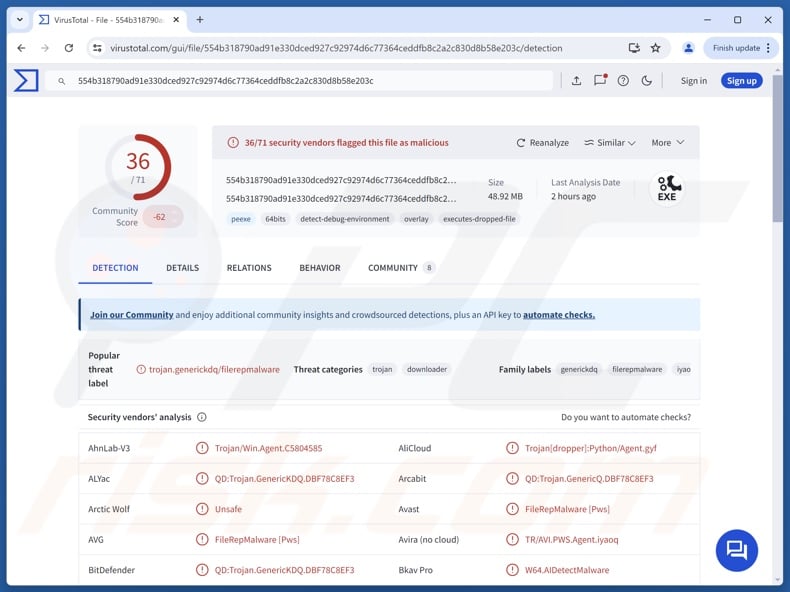
Stealit malware overview
Stealit has anti-analysis mechanisms – including strong obfuscation, VM (Virtual Machine) and sandbox detection, and anti-debugging abilities. This malware utilizes persistence-ensuring techniques, such as setting itself to start upon each system reboot automatically.
As mentioned in the introduction, Stealit functions as a Remote Access Trojan (RAT) – by enabling remote access and control over infected machines. It has spyware capabilities as well. Stealit can execute various commands, restart/shutdown systems, play audio, display fake system notifications, record video via the device's cameras, live-stream the desktop, and so on.
This program can upload and execute files – an ability that can be used to cause chain infections (e.g., infiltrate trojans, ransomware, cryptominers, etc.). According to Stealit's promotional material, it is capable of introducing any payload into systems. Generally, software of this kind tends to operate within certain specifications or limitations.
This malicious program has data-encrypting ransomware functionalities – it can encrypt files, append filenames with an extension, change the desktop wallpaper, drop ransom notes, and directly chat with the victim through their device.
Additionally, this malware has stealer capabilities. Stealit can extract data from browsers, browser extensions, cryptocurrency wallets, messengers, and gaming-related software (full list below). It targets Internet cookies, auto-fills (e.g., usernames, personally identifiable details, etc.), passwords/passphrases, sessions, 2FA/MFA codes, and so forth.
The malware operates as a file grabber – it can search and download files from the Desktop, Documents, Downloads, and other directories. Targeted files include sensitive documents, cryptowallet backups, Discord messenger 2FA codes, etc.
Stealit's Android version likewise has spyware, stealer, and (screen-locking) ransomware functionalities. It can live-stream (i.e., the screen, audio via microphones, and video via cameras), track the victim's location in real-time, carry out a factory reset, open specific URLs, download/install APKs (i.e., cause chain infections), manage files (e.g., view, delete, exfiltrate), record keystrokes (keylogging), access accounts logged into through the device, obtain contact lists, read/send SMSes, view call logs, and manage calls.
As Stealit is capable of sending text messages and making calls, it could be used as Toll Fraud malware. It also has the capabilities required to function as screen-locking ransomware – display a screen-locking custom message that may make ransom demands for access recovery and exert pressure by threatening a device reset. This program might be utilized to perform overlay attacks via WebView – display phishing screens that imitate genuine pages to collect vulnerable data (e.g., log-in credentials, credit/debit card numbers, etc.).
Stealit's promotional material states that there are plans to implement browser data stealer abilities into the Android variant. Malware developers commonly improve upon their software and methodologies. Therefore, potential future iterations of Stealit could have additional/different capabilities and features.
To summarize, the presence of malicious software like Stealit on devices can lead to multiple system infections, permanent data loss, severe privacy issues, financial losses, and identity theft.
| Name | Stealit Remote Access Trojan (RAT) |
| Threat Type | Trojan, Remote Access Trojan, RAT, stealer, password-stealing virus, banking malware, spyware, ransomware. |
| Detection Names | Avast (FileRepMalware [Pws]), Combo Cleaner (QD:Trojan.GenericKDQ.DBF78C8EF3), ESET-NOD32 (JS/Spy.StealIt.A), Kaspersky (Trojan-Downloader.Win32.Inject.cd), Microsoft (Trojan:Win32/Alevaul!rfn), Full List Of Detections (VirusTotal) |
| Symptoms | Trojans are designed to stealthily infiltrate the victim's device and remain silent, and thus no particular symptoms are clearly visible. Should the ransomware capabilities be activated, files stored on the device cannot be opened and have a different extension. A ransom-demanding message is displayed on the desktop. |
| Distribution methods | Infected email attachments, malicious online advertisements, social engineering, software 'cracks'. |
| Damage | Stolen passwords and banking information, identity theft, the victim's computer added to a botnet. |
| Malware Removal (Windows) |
To eliminate possible malware infections, scan your computer with legitimate antivirus software. Our security researchers recommend using Combo Cleaner. Download Combo CleanerTo use full-featured product, you have to purchase a license for Combo Cleaner. 7 days free trial available. Combo Cleaner is owned and operated by RCS LT, the parent company of PCRisk.com. |
Similar malware examples
Malware is a broad term that covers programs with a broad range of functionalities. Like Stealit, malicious software can have a multitude of harmful functions or an incredibly narrow and specified application.
SilentSync, MostereRAT, ZynorRAT – are some of our latest articles on Windows-targeting remote access trojans, and Klopatra, RedHook, RatOn – on Android RATs.
Remember that regardless of how malware operates – its presence on a system threatens device integrity and user safety. Therefore, all threats must be eliminated immediately upon detection.
How did Stealit infiltrate my computer?
As of the time of writing, the developers of Stealit are offering it for sale. The developers have a Telegram channel, and the malware has a dedicated website. Hence, how this program is distributed may depend on the modus operandi of the cyber criminals using it (i.e., methods may differ between attacks).
It has been observed that the filenames of files used to spread Stealit relate to VPNs and video games. Older Stealit campaigns relied on Electron-packaged NSIS installers (containing Node.js scripts). Later campaigns moved on to utilizing the SEA (Single Executable Application) feature of Node.js for distribution. The infectious files often arrived in compressed archives of popular formats (like ZIPs).
It is noteworthy that various disguises and proliferation methods are possible. Typically, malicious software is distributed by relying on phishing and social engineering techniques. Virulent files can be archives (ZIP, RAR, etc.), executables (.exe, .run, etc.), documents (PDF, Microsoft Office, Microsoft OneNote, etc.), JavaScript, and so on. Merely opening an infectious file can be enough to trigger the malware download/installation chain.
The most widespread distribution techniques include: drive-by (stealthy/deceptive) downloads, untrustworthy download sources (e.g., freeware and third-party sites, Peer-to-Peer sharing networks, etc.), pirated programs/media, illegal software activation tools ("cracks"), malvertising, online scams, malicious attachments or links in spam emails/messages, and fake updates.
Some malicious programs can self-spread through local networks and removable storage devices (e.g., external hard drives, USB flash drives, etc.).
How to avoid installation of malware?
Caution is essential to device and user safety. Therefore, download only from official and verified channels. Activate and update software using functions/tools provided by legitimate developers, as those acquired from third-parties can contain malware.
Additionally, be vigilant when browsing since the Internet is rife with deceptive and dangerous content. Treat incoming emails and other messages with care. Do not open attachments or links present in suspicious/irrelevant communications.
It is paramount to have a reputable antivirus installed and kept up-to-date. Security programs must be used to run regular system scans and to remove detected threats. If you believe that your computer is already infected, we recommend running a scan with Combo Cleaner Antivirus for Windows to automatically eliminate infiltrated malware.
List of software targeted by Stealit malware;
Targeted browsers:
7Star, 360 Browser, Amigo, Brave, Cent Browser, Chedot, ChromePlus, Chromium, Citrio, CocCoc, Comodo Dragon, Coowon, DC Browser, Elements Browser, Epic Privacy Browser, Google Chrome, Google Chrome Canary, Iridium, K-Melon, Kometa, Liebao, Maxthon3, Microsoft Edge, Mozilla Firefox, Opera, Orbitum, QIP Surf, Sleipnir, Slimjet, Sputnik, Thorium, Toch, UCozMedia Uran, UR Browser, Vivaldi, Yandex.
Targeted cryptowallets and cryptocurrency-related browser extensions:
Atomic, Binance Chain, BitApp, BoltX, Braavos, Brave, Coin98, Coinbase, Crypto.com, Equal, Ethos, EVER, Exodus, Fewcha Move, Guarda, Guild, Harmony, iWallet, Jaxx Liberty, KardiaChain, Keplr, Liquality, Maiar DeFi Wallet, Martian Aptos, Math, MetaMask, MewCx, Nami, Nifty, OKX, Pali, Petra Aptos, Phantom, Ready Wallet (Argent X), Ronin, Saturn, Sender, Sollet, Sui, Suiet, Temple, Terra Station, TON, TronLink, Trust, Wombat, XDEFI, Yoroi.
Targeted messengers:
- Telegram
Targeted gaming-related software:
- Epic Games
- GrowTopia
- Minecraft
- Roblox
- Steam
Screenshot of Stealit malware's Web control panel:
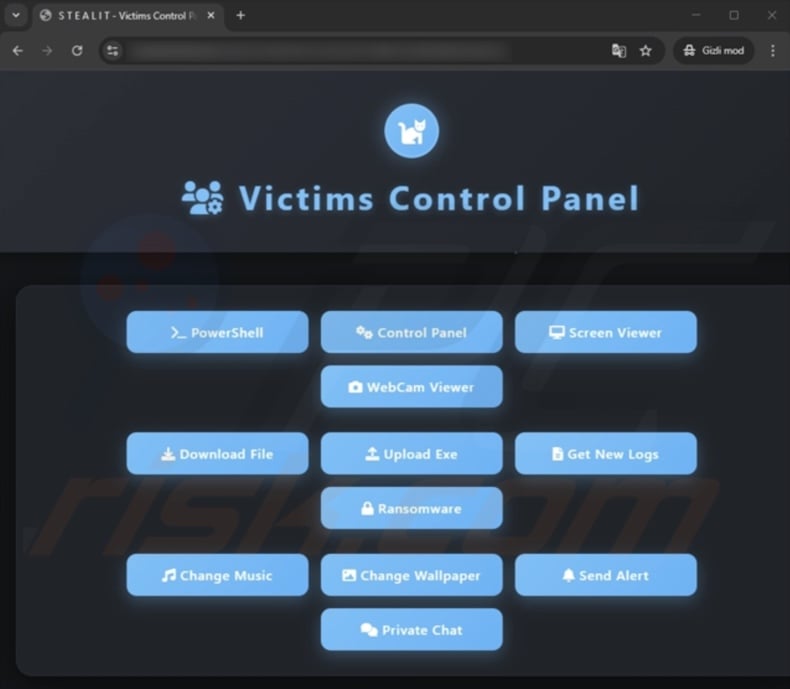
Screenshot of the website used to sell Stealit:
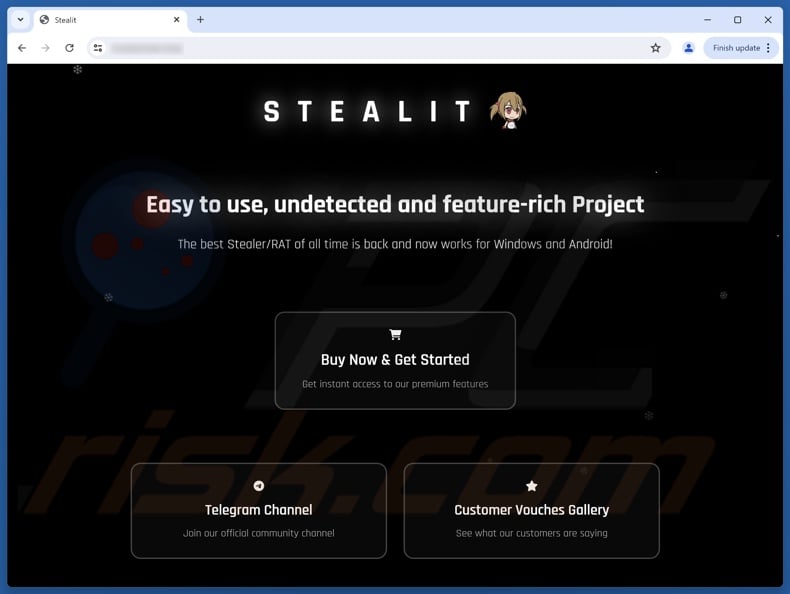
Instant automatic malware removal:
Manual threat removal might be a lengthy and complicated process that requires advanced IT skills. Combo Cleaner is a professional automatic malware removal tool that is recommended to get rid of malware. Download it by clicking the button below:
DOWNLOAD Combo CleanerBy downloading any software listed on this website you agree to our Privacy Policy and Terms of Use. To use full-featured product, you have to purchase a license for Combo Cleaner. 7 days free trial available. Combo Cleaner is owned and operated by RCS LT, the parent company of PCRisk.com.
Quick menu:
- What is Stealit?
- STEP 1. Manual removal of Stealit malware.
- STEP 2. Check if your computer is clean.
How to remove malware manually?
Manual malware removal is a complicated task - usually it is best to allow antivirus or anti-malware programs to do this automatically. To remove this malware we recommend using Combo Cleaner Antivirus for Windows.
If you wish to remove malware manually, the first step is to identify the name of the malware that you are trying to remove. Here is an example of a suspicious program running on a user's computer:
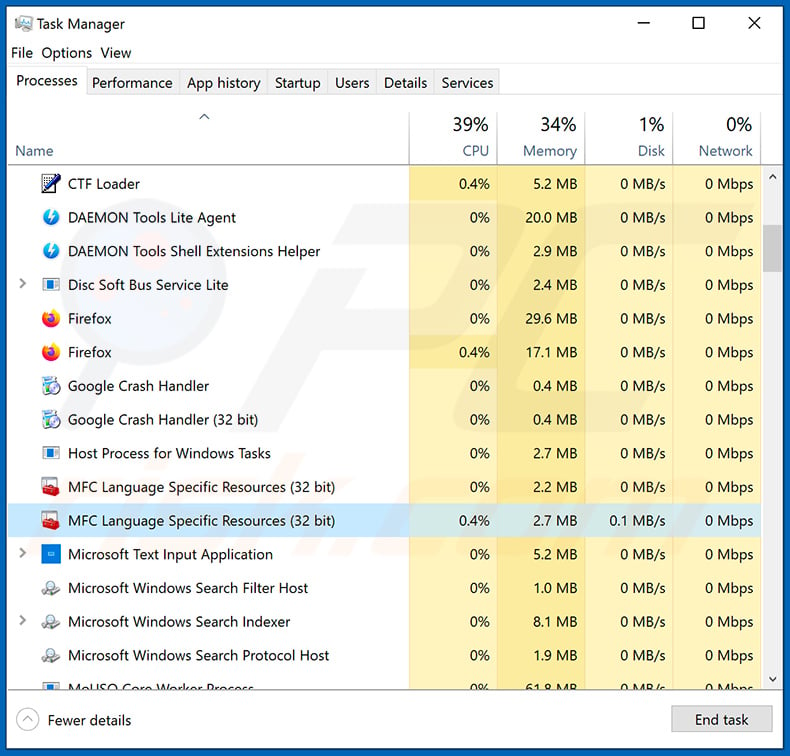
If you checked the list of programs running on your computer, for example, using task manager, and identified a program that looks suspicious, you should continue with these steps:
 Download a program called Autoruns. This program shows auto-start applications, Registry, and file system locations:
Download a program called Autoruns. This program shows auto-start applications, Registry, and file system locations:
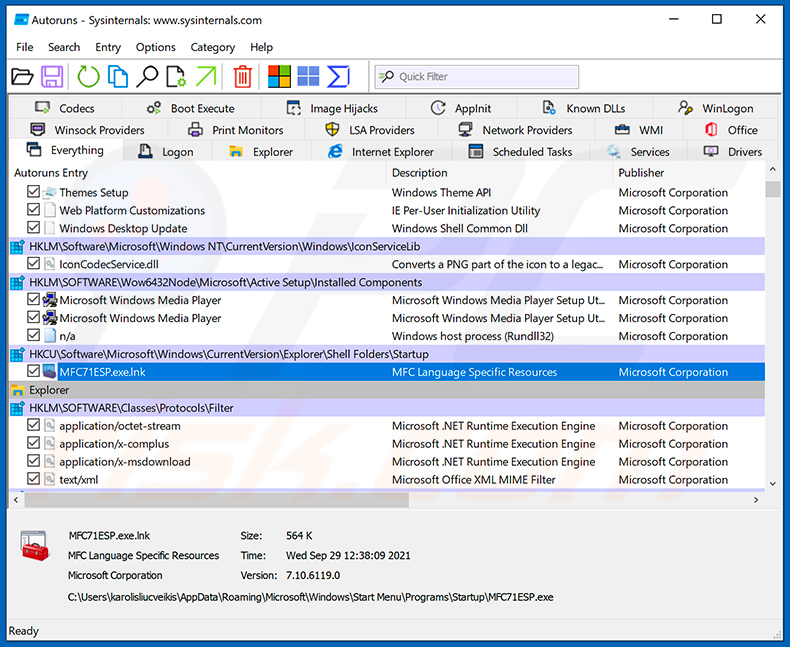
 Restart your computer into Safe Mode:
Restart your computer into Safe Mode:
Windows XP and Windows 7 users: Start your computer in Safe Mode. Click Start, click Shut Down, click Restart, click OK. During your computer start process, press the F8 key on your keyboard multiple times until you see the Windows Advanced Option menu, and then select Safe Mode with Networking from the list.
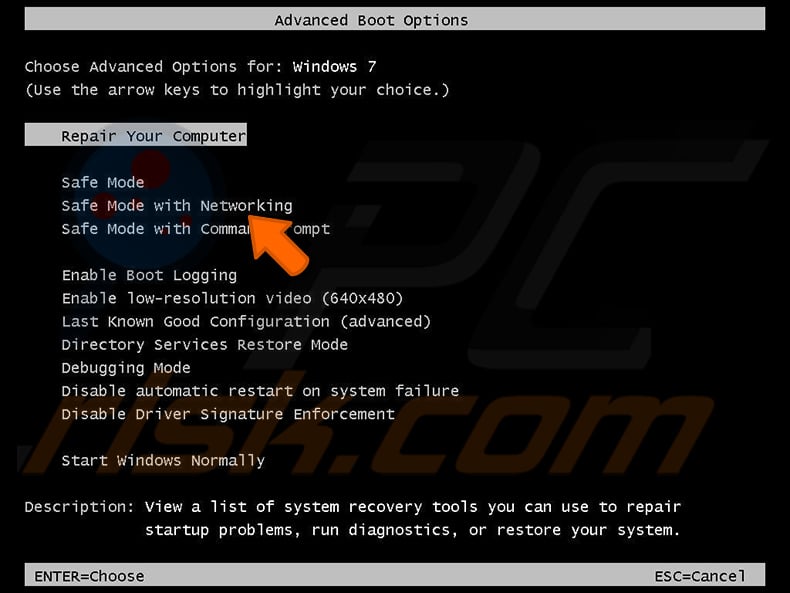
Video showing how to start Windows 7 in "Safe Mode with Networking":
Windows 8 users: Start Windows 8 is Safe Mode with Networking - Go to Windows 8 Start Screen, type Advanced, in the search results select Settings. Click Advanced startup options, in the opened "General PC Settings" window, select Advanced startup.
Click the "Restart now" button. Your computer will now restart into the "Advanced Startup options menu". Click the "Troubleshoot" button, and then click the "Advanced options" button. In the advanced option screen, click "Startup settings".
Click the "Restart" button. Your PC will restart into the Startup Settings screen. Press F5 to boot in Safe Mode with Networking.
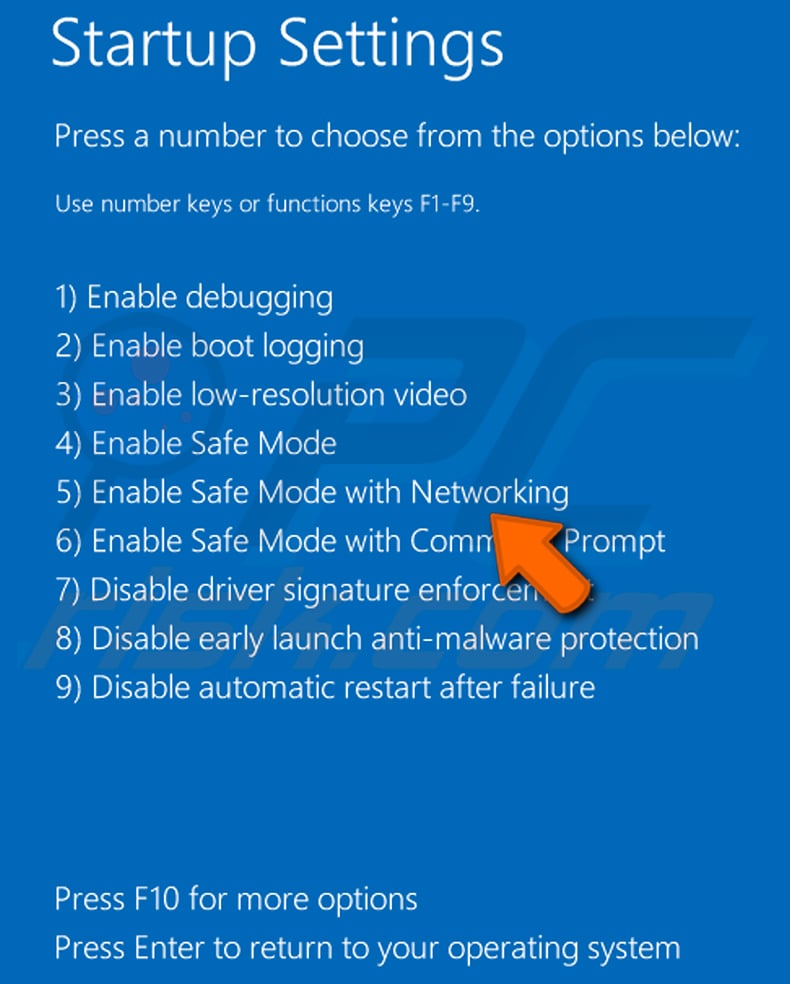
Video showing how to start Windows 8 in "Safe Mode with Networking":
Windows 10 users: Click the Windows logo and select the Power icon. In the opened menu click "Restart" while holding "Shift" button on your keyboard. In the "choose an option" window click on the "Troubleshoot", next select "Advanced options".
In the advanced options menu select "Startup Settings" and click on the "Restart" button. In the following window you should click the "F5" button on your keyboard. This will restart your operating system in safe mode with networking.
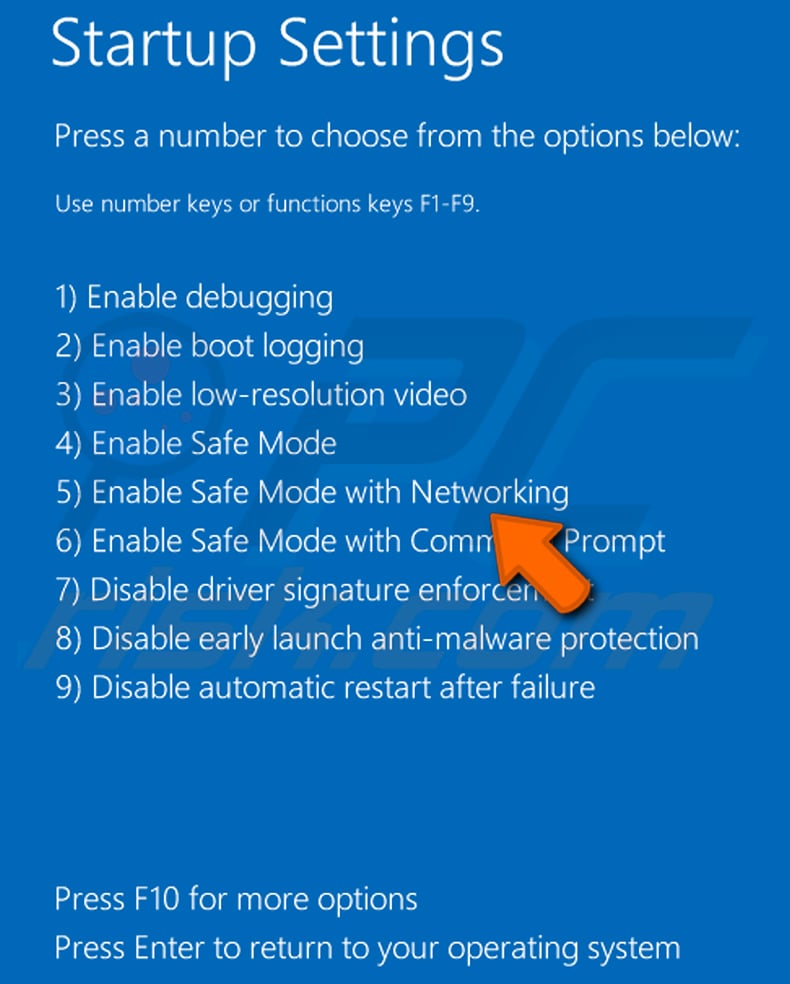
Video showing how to start Windows 10 in "Safe Mode with Networking":
 Extract the downloaded archive and run the Autoruns.exe file.
Extract the downloaded archive and run the Autoruns.exe file.
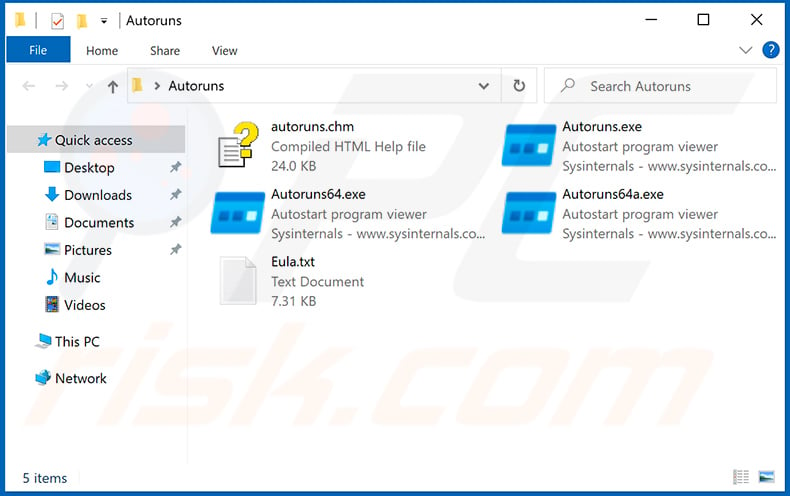
 In the Autoruns application, click "Options" at the top and uncheck "Hide Empty Locations" and "Hide Windows Entries" options. After this procedure, click the "Refresh" icon.
In the Autoruns application, click "Options" at the top and uncheck "Hide Empty Locations" and "Hide Windows Entries" options. After this procedure, click the "Refresh" icon.
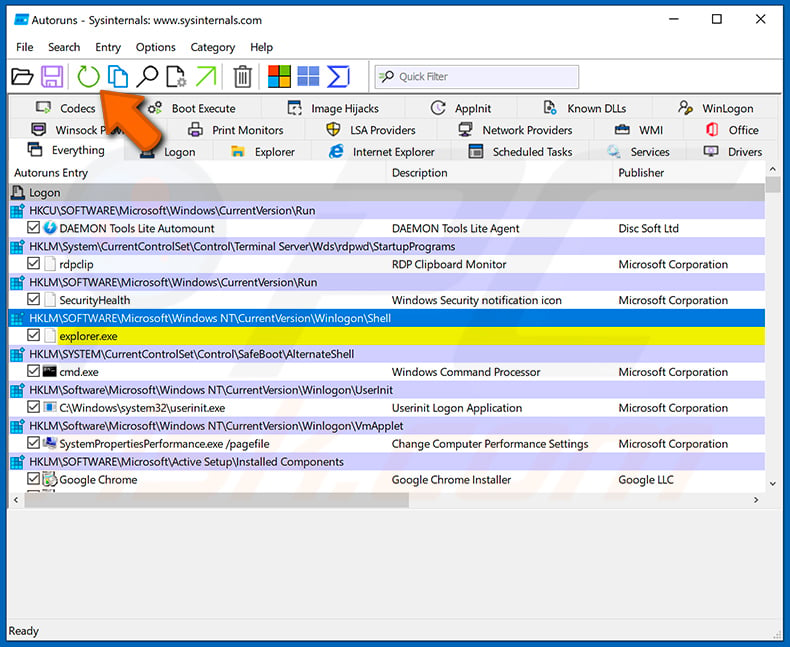
 Check the list provided by the Autoruns application and locate the malware file that you want to eliminate.
Check the list provided by the Autoruns application and locate the malware file that you want to eliminate.
You should write down its full path and name. Note that some malware hides process names under legitimate Windows process names. At this stage, it is very important to avoid removing system files. After you locate the suspicious program you wish to remove, right click your mouse over its name and choose "Delete".
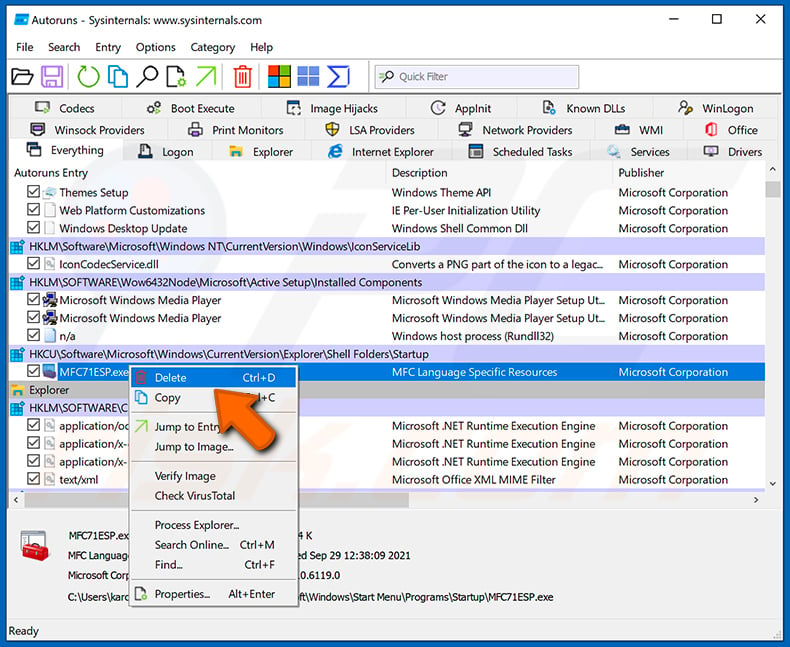
After removing the malware through the Autoruns application (this ensures that the malware will not run automatically on the next system startup), you should search for the malware name on your computer. Be sure to enable hidden files and folders before proceeding. If you find the filename of the malware, be sure to remove it.
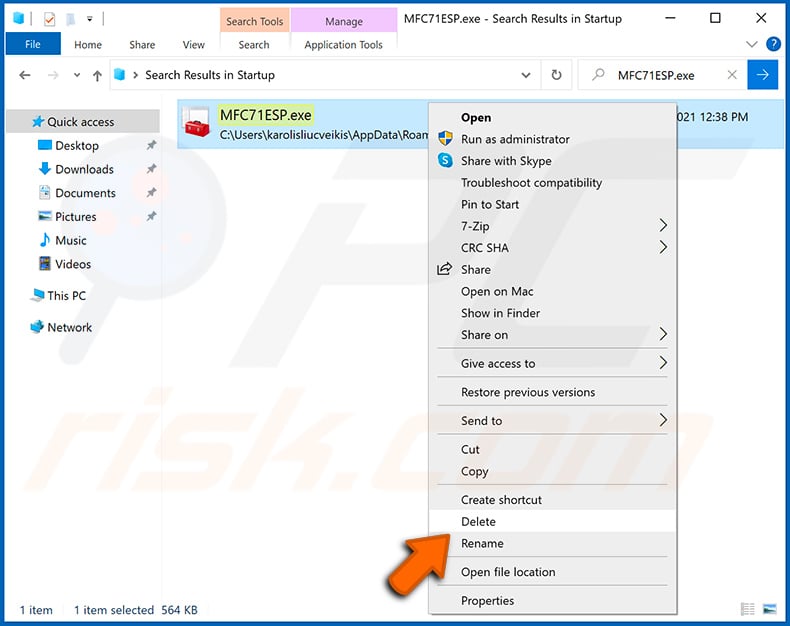
Reboot your computer in normal mode. Following these steps should remove any malware from your computer. Note that manual threat removal requires advanced computer skills. If you do not have these skills, leave malware removal to antivirus and anti-malware programs.
These steps might not work with advanced malware infections. As always it is best to prevent infection than try to remove malware later. To keep your computer safe, install the latest operating system updates and use antivirus software. To be sure your computer is free of malware infections, we recommend scanning it with Combo Cleaner Antivirus for Windows.
Frequently Asked Questions (FAQ)
My computer is infected with Stealit malware, should I format my storage device to get rid of it?
Most likely, no. Malware removal rarely necessitates formatting.
What are the biggest issues that Stealit malware can cause?
The dangers posed by an infection depend on the malware's functionalities and the attackers' goals. Stealit is a highly functional piece of malicious software. Its presence on a system can lead to multiple system infections, data loss, severe privacy issues, financial losses, and identity theft.
What is the purpose of Stealit malware?
Malware is mainly used for financial gain. However, attacks can also be driven by the attackers' amusement or personal grudges, hacktivism, process disruption (e.g., sites, services, companies, etc.), and political/geopolitical motivations.
How did Stealit malware infiltrate my computer?
The most widespread malware distribution techniques include: drive-by downloads, suspicious download sources (e.g., freeware and free file-hosting websites, P2P sharing networks, etc.), online scams, malvertising, spam mail, pirated content, illegal software activation tools ("cracks"), and fake updates. Furthermore, some malicious programs can self-proliferate via local networks and removable storage devices.
Will Combo Cleaner protect me from malware?
Yes, Combo Cleaner is capable of detecting and removing nearly all known malware infections. Note that since sophisticated malicious programs tend to hide deep within systems – performing a complete system scan is crucial.
Share:

Tomas Meskauskas
Expert security researcher, professional malware analyst
I am passionate about computer security and technology. I have an experience of over 10 years working in various companies related to computer technical issue solving and Internet security. I have been working as an author and editor for pcrisk.com since 2010. Follow me on Twitter and LinkedIn to stay informed about the latest online security threats.
PCrisk security portal is brought by a company RCS LT.
Joined forces of security researchers help educate computer users about the latest online security threats. More information about the company RCS LT.
Our malware removal guides are free. However, if you want to support us you can send us a donation.
DonatePCrisk security portal is brought by a company RCS LT.
Joined forces of security researchers help educate computer users about the latest online security threats. More information about the company RCS LT.
Our malware removal guides are free. However, if you want to support us you can send us a donation.
Donate
▼ Show Discussion